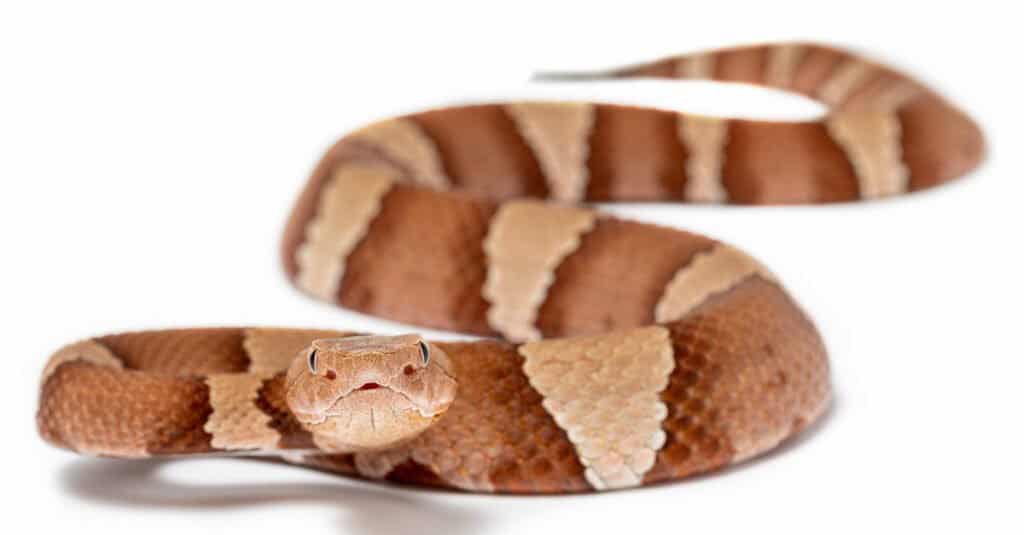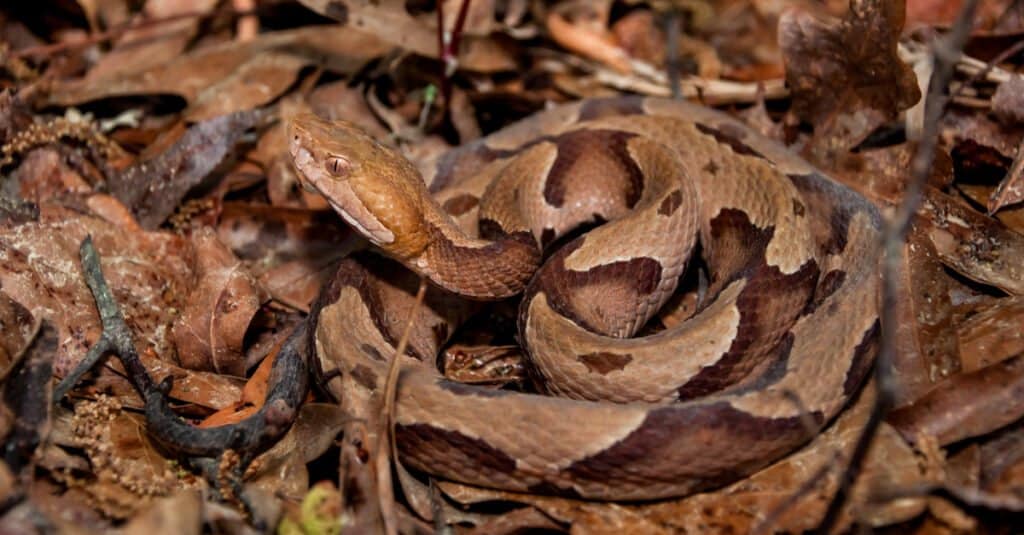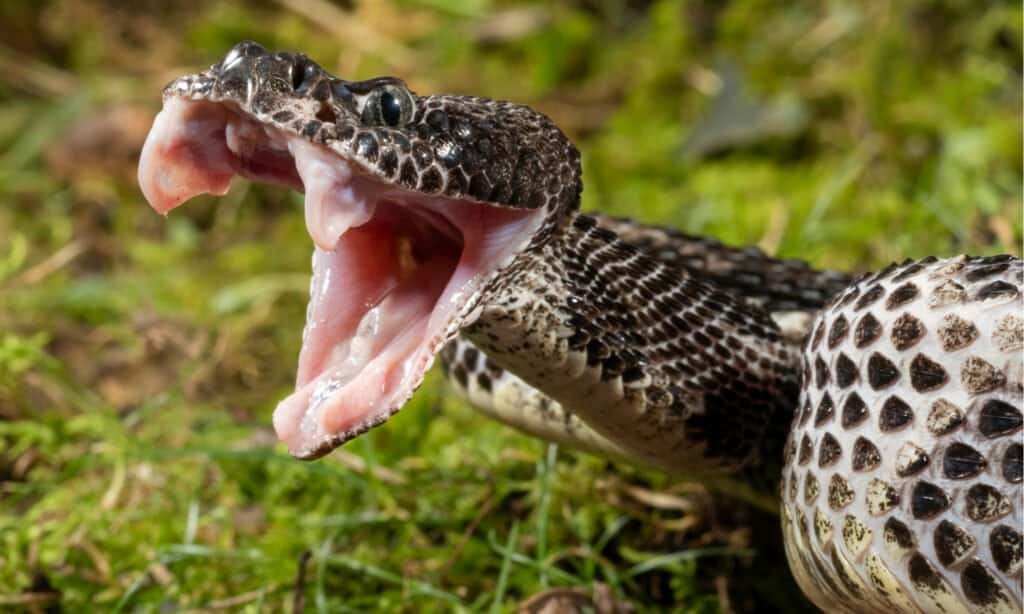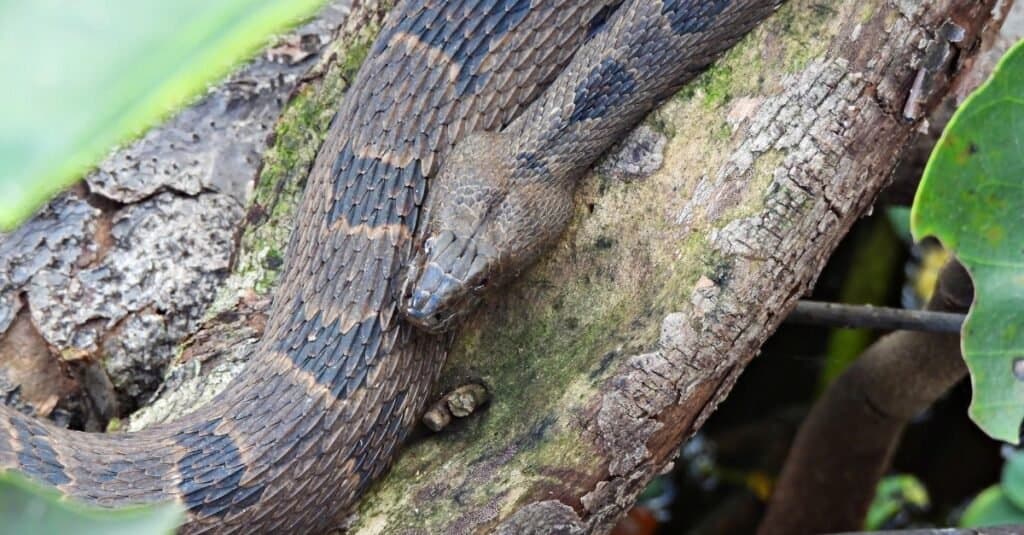Copperheads are one of the most commonly encountered venomous snakes in the US, but where exactly do they live? Arkansas is home to a diverse ecosystem of wildlife, including snakes! There are 36 recognized species of snake in the state, and six of them are venomous. The copperhead is among them, but do they ever bite people? Let’s take a look at copperheads in Arkansas, where they live, and how often they bite.
Do copperheads live in Arkansas?

There are two recognized subspecies of copperhead in Arkansas.
©Scott Delony/Shutterstock.com
Copperheads live across the entire state of Arkansas, with two subspecies being recognized.
The United States is home to many snake species, but the copperhead is among the most famous. As members of the pit vipers, copperheads are venomous and known for their potent bite. Other pit vipers include the rattlesnake and the cottonmouth, both of which live in Arkansas. Despite their reputation, however, copperheads are beautiful creatures with an important role in the ecosystems they inhabit.
Although venomous snakes can be a danger to humans, bites are extremely rare, and deaths are even rarer. In fact, the copperhead is usually regarded as the least dangerous of all the pit vipers. If bitten, medical treatment is necessary, but fatalities usually only occur when there is already an allergic reaction.
Identifying the subspecies of copperheads in Arkansas

Although two subspecies of copperhead are widely recognized, they are taxonomically considered the same and have since been combined.
©Jay Ondreicka/Shutterstock.com
The number of recognized subspecies is currently under some restructuring regarding copperheads. Historically, there were five subspecies listed, two of which live in Arkansas. The two species, the southern copperhead, and the Osage copperhead have since been combined into a single group. This revised taxonomy has been confirmed with DNA evidence, but many resources still differentiate between the old subspecies. The new, combined group of copperheads is known as the eastern copperhead, but we will break them into their historical groups today to learn a bit about them.
Identifying markers that all copperheads share
Although there are various subspecies of copperhead, there are still some identifying factors that can help you identify a copperhead no matter where you are. All copperheads have the following traits:
- brown, tan, or coppery tones across their body, although the exact shading can vary slightly
- golden yellow eyes that resemble a cat’s
- flat, triangular head
- heat-sensing pits between their nostrils and eyes on either side of their head
- hourglass banding patterns, although the Trans-Peco and broadband copperhead doesn’t always have this pattern
Aside from those things, let’s look at the specifics of what these snakes look like and where they live in Arkansas.
Southern copperhead
Southern copperheads are among the most common of the copperhead subspecies. These snakes are usually reddish-brown and copper and have clear hourglass patterns across their backs. The thick portion of the hourglass is situated on the snake’s sides, and the thin portion is along the spine. These snakes were historically their own subspecies but are now recognized simply as the eastern copperhead.
Southern copperheads are found all across the state of Arkansas. Additionally, the state is a large intergrade zone, meaning both subspecies live together in many places.
Osage copperhead
Osage copperheads are less common than southern copperheads, and they look quite similar. There are some field guides that southern copperheads have more spotting between the bands than the Osage copperhead, but these aren’t reliable tells. In fact, Herps of Arkansas, a herpetology resource documenting snakes in the state, says the following:
This species is found statewide. Field guide descriptions are mostly unreliable for distinguishing between the two subspecies in the state. The Copperhead is the most common and commonly encountered venomous snake in Arkansas.
Herps of Arkansas
Part of the reason that these two subspecies were combined into one is their similarity. Still, there seem to be some resources that show the Osage copperhead to be grayer in color, whereas the southern copperhead is more reddish-brown. That may not be reliable, however.
The Osage copperhead can be found across the entire state of Arkansas.
How often are people bitten by copperheads in Arkansas?

Copperhead bites are serious, but they are rarely fatal.
©iStock.com/David Kenny
Copperheads are venomous snakes, and they bite people. Still, this is no cause for concern. In fact, the data from the American Associate of Poison Control Centers shows that from the year 1983 to 2018, there were a total of 68 snake-bite-related deaths in the United States. Of these deaths, the copperhead was responsible for three.
Additionally, current data shows that there are around 2,290 people bitten by copperheads each year in the United States. Of all copperhead bites, the fatality rate of 2,290 people a year is around 0.01%. Most of the deaths caused by copperhead bites are from an associated allergy, similar to someone being allergic to bee sting venom. The resulting deaths are from anaphylaxis, not the venom itself.
If bitten by a copperhead, seek medical attention immediately. The area will swell, and administration of antivenom is imperative for reduced complications and damage.
Snakes commonly mistaken for copperheads in Arkansas
There are quite a few species of snake in Arkansas, many of which look alike. Here are three examples of snakes that could potentially be mistaken for a copperhead. When in doubt, check for the basics for all copperheads that we listed above.
Northern cottonmouth

Cottonmouths are thick snakes with bright white mouths.
©Jay Ondreicka/Shutterstock.com
Northern cottonmouths are venomous, aquatic snakes that live in Arkansas. They are larger, thicker snakes that get their name from the bright white mouths they flash as a warning. They occasionally have patterns like a copperhead, but the cottonmouth is darker and washed out. Copperheads are bright and more distinct.
Timber rattlesnake

Timber rattlesnakes have rattles and chevrons across their back.
©Joe McDonald/Shutterstock.com
The timber rattlesnake is another venomous snake that can occasionally look like the copperhead. The two best ways to tell the difference between the two are that timbers have chevrons instead of hourglass shapes as patterns, and timbers have rattles they shake when they are approached by a predator.
Watersnakes

Watersnakes are aquatic snakes that are nonvenomous.
©iStock.com/passion4nature
There are many different species of watersnake that live in Arkansas. These snakes are often killed because of their similarity to copperheads and cottonmouths. None of these watersnakes are venomous, however. A good way to tell the difference is that watersnakes don’t have hourglass patterns like the copperhead and don’t have heat-sensing pits on their snout. Additionally, their heads aren’t as flat as the copperhead and cottonmouth are.
The photo featured at the top of this post is © Joe McDonald/Shutterstock.com
Discover the "Monster" Snake 5X Bigger than an Anaconda
Every day A-Z Animals sends out some of the most incredible facts in the world from our free newsletter. Want to discover the 10 most beautiful snakes in the world, a "snake island" where you're never more than 3 feet from danger, or a "monster" snake 5X larger than an anaconda? Then sign up right now and you'll start receiving our daily newsletter absolutely free.
Thank you for reading! Have some feedback for us? Contact the AZ Animals editorial team.






